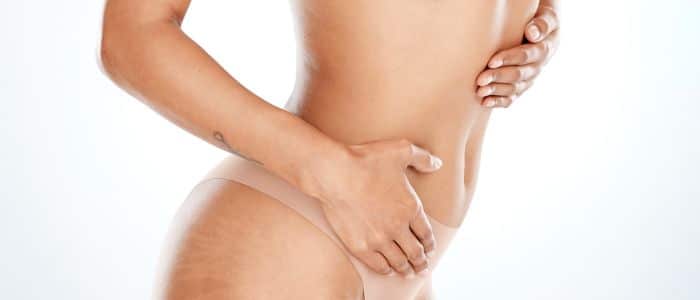
- Recommendations for Reducing Swelling and Bruising after Abdominoplasty from Anca Breahna
- Download the Tummy Tuck Guide
- Why Swelling and Bruising Occur after Tummy Tuck Surgery
- Pre-Surgery Preparations to Reduce Bruising and Swelling after Tummy Tuck
- Post-Tummy Tuck Care
- Nutrition and Diet to Reduce Swelling and Bruising after Tummy Tuck
- Home Remedies to Reduce Swelling and Bruising after Tummy Tuck
- FAQs about How to Reduce Swelling and Bruising after Tummy Tuck Surgery
- Can I use over-the-counter pain relievers to manage discomfort and swelling after a tummy tuck?
- How long should I wear compression garments after a tummy tuck?
- What can I do to prevent infection at the incision site?
- Are there any dietary restrictions I should follow after a tummy tuck?
- When can I resume strenuous exercise and physical activities after a tummy tuck?
- Further Reading about Abdominoplasty Surgery with Consultant Plastic Surgeon Anca Breahna
- Medical References about Tummy Tuck Surgery
Recommendations for Reducing Swelling and Bruising after Abdominoplasty from Anca Breahna
The tummy tuck procedure aims to remove excess skin and fat from the abdominal area, creating a flatter and firmer abdomen. While the results can be remarkable, it’s important to be prepared for the recovery process, which may include swelling and bruising.
Consulting with a board-certified plastic surgeon, such as Anca Breahna, is a crucial step in ensuring a safe and successful tummy tuck procedure. Proper post-operative care and following the advice of your surgeon are equally essential to minimise swelling and bruising and expedite your healing process. In this blog, we will explore various strategies and tips for reducing swelling and bruising after tummy tuck surgery, as recommended by Chester Consultant Plastic Surgeon Anca Breahna.
Download the Tummy Tuck Guide

Why Swelling and Bruising Occur after Tummy Tuck Surgery
Before getting into the ways to reduce swelling and bruising, it’s essential to understand why these post-operative symptoms occur:
Swelling after Tummy Tuck Surgery
Swelling, or edema, is a typical response following abdominoplasty and can be attributed to several factors:
- Inflammatory Reaction: The body naturally responds to the trauma of surgery by triggering an inflammatory response. This process is critical for healing but also leads to an accumulation of fluids in the tissues surrounding the surgical site. The inflammation is a protective measure, involving increased blood flow and the migration of white blood cells to the area to fight infection and repair damaged tissues
- Blood Circulation Changes: The abdominoplasty procedure involves the manipulation and disruption of blood vessels within the abdominal area. This alteration can temporarily impede proper blood circulation, leading to fluid retention and subsequent swelling. The body’s attempt to maintain normal blood flow in the face of surgical alterations contributes to this fluid buildup
- Lymphatic System Impairment: The lymphatic system plays a pivotal role in draining excess fluids from body tissues. Surgical trauma during a tummy tuck can temporarily impair the functionality of this system. When the lymphatic channels are disrupted or damaged, they become less efficient in removing the excess fluid, contributing significantly to postoperative swelling
Bruising after Abdominoplasty
Bruising is another common side effect and results primarily from:
- Blood Vessel Damage: The surgical process involves incisions and manipulations beneath the skin’s surface, which can lead to damage to small blood vessels. This damage is often inevitable as the surgeon works to remove excess skin and fat, tighten abdominal muscles, and reshape the area. When these blood vessels are injured, blood leaks into the surrounding tissue, causing the typical discolouration seen in bruises
- Formation of Haematomas: In certain cases, a haematoma can develop post-surgery. A haematoma is a localised collection of blood outside the blood vessels, usually in liquid form within the tissue. This occurrence is more significant than simple bruising and can lead to extensive discolouration and swelling. Haematomas can vary in size and may sometimes require additional medical intervention for resolution
Now that we understand why swelling and bruising occur, let’s explore the strategies to minimise these post-operative side effects.
Pre-Surgery Preparations to Reduce Bruising and Swelling after Tummy Tuck
Choose an Experienced Surgeon
The first step to reducing the risk of complications, including excessive swelling and bruising, is selecting a skilled and experienced plastic surgeon like Anca Breahna. A board-certified surgeon with a proven track record will prioritise safety and employ advanced surgical techniques to minimise trauma during the procedure.
Follow Pre-Operative Instructions
Anca will provide you with a list of pre-operative instructions to follow, such as avoiding certain medications, quitting smoking, and maintaining a healthy diet. Adhering to these recommendations can help improve your body’s readiness for surgery and potentially reduce post-operative complications.
Post-Tummy Tuck Care
Compression Garments
One of the most effective ways to manage swelling and bruising after a tummy tuck is by wearing compression garments as directed by Anca. These specially designed garments provide gentle pressure on the treated area, helping to minimise fluid build up and support the healing process.
Elevate Your Upper Body
Elevating your upper body while resting or sleeping can aid in reducing swelling. Use pillows or an adjustable bed to keep your head and upper body at an incline of around 30-45 degrees. This position promotes better blood circulation and minimises fluid retention in the abdominal area.
Stay Hydrated
Proper hydration is crucial during your recovery period. Drinking enough water helps your body flush out toxins and excess fluids, potentially reducing swelling. Make sure to consult with your surgeon for specific recommendations, as excessive water intake may not be suitable for everyone.
Gentle Movement and Walking
While strenuous activities are off-limits during the early days of recovery, gentle movement and short walks are encouraged. These activities help improve circulation and prevent blood clots. Always follow your surgeon’s guidance regarding the appropriate level of activity for your specific case.
Pain Management
Pain and discomfort are common after surgery. Anca will prescribe pain medication to manage your discomfort. By staying on top of your pain management regimen, you can reduce stress on your body, which may contribute to swelling.
Use Arnica Montana
Arnica Montana is a homeopathic remedy that some patients find helpful in reducing bruising and swelling. Consult with Anca before using any supplements or homeopathic remedies to ensure they are safe and appropriate for your recovery.
Nutrition and Diet to Reduce Swelling and Bruising after Tummy Tuck
Maintain a Balanced Diet
Eating a well-balanced diet rich in nutrients is essential for a smooth recovery. Focus on consuming a variety of fruits, vegetables, lean proteins, and whole grains. Nutrients like vitamin C and zinc are particularly important for wound healing.
Reduce Sodium Intake
Excessive sodium can contribute to water retention and exacerbate swelling. Avoid high-sodium foods, such as processed snacks and fast food, and opt for low-sodium options instead.
Consider Supplements
In some cases, Anca may recommend specific supplements to aid in healing and reduce swelling. Omega-3 fatty acids, bromelain, and quercetin are examples of supplements that may be beneficial.
Home Remedies to Reduce Swelling and Bruising after Tummy Tuck
Cold Compresses
Applying cold compresses to the swollen or bruised areas can help reduce inflammation and alleviate discomfort. Use a clean cloth or ice pack wrapped in a thin towel and apply it for short intervals, following Anca’s recommendations.
Use Aloe Vera Gel
Aloe vera has soothing and anti-inflammatory properties. Applying aloe vera gel to your incisions and bruised areas can help reduce swelling and promote healing. Ensure the product is pure and free of added chemicals.
Bromelain Supplements
Bromelain, an enzyme found in pineapple, has anti-inflammatory properties and may help reduce swelling and bruising.
Maintain a Stable Body Temperature
Avoid hot baths, saunas, or hot tubs during the initial recovery period, as excessive heat can exacerbate swelling. Opt for lukewarm showers instead.
Tummy tuck surgery can provide incredible results, but it’s important to be prepared for the recovery process, which includes managing swelling and bruising. By following the guidance of a skilled plastic surgeon like Anca and implementing the strategies outlined in this blog, you can significantly reduce post-operative swelling and bruising, ultimately enjoying the full benefits of your tummy tuck procedure.
FAQs about How to Reduce Swelling and Bruising after Tummy Tuck Surgery
Can I use over-the-counter pain relievers to manage discomfort and swelling after a tummy tuck?
- While over-the-counter pain relievers like ibuprofen or aspirin may seem like a convenient option, it’s crucial to consult Anca before using them. Some of these medications can thin the blood, potentially increasing the risk of bleeding and bruising. Anca will provide you with specific recommendations for pain management during your recovery.
How long should I wear compression garments after a tummy tuck?
- The duration of compression garment use varies from patient to patient and depends on Anca’s recommendations. In most cases, you’ll wear compression garments for several weeks to help reduce swelling and support the healing process. Follow your surgeon’s instructions regarding when and for how long to wear them.
What can I do to prevent infection at the incision site?
- Reducing the risk of infection is crucial during the recovery period. Follow Anca’s post-operative care instructions meticulously, which may include keeping the incision area clean and dry, using antibiotic ointments as directed, and avoiding exposure to contaminants. If you notice signs of infection, such as increased redness, warmth, or discharge, contact your surgeon immediately.
Are there any dietary restrictions I should follow after a tummy tuck?
- While there are no strict dietary restrictions, maintaining a healthy and balanced diet is essential for optimal healing. Focus on foods rich in vitamins, minerals, and proteins that promote tissue repair. Avoid excessive sodium intake, as it can contribute to swelling.
When can I resume strenuous exercise and physical activities after a tummy tuck?
- The timeline for resuming exercise and strenuous activities varies depending on your individual healing process. You should avoid strenuous exercises and heavy lifting for at least six to eight weeks following a tummy tuck. Anca will provide you with specific guidelines and timelines based on your progress during follow-up appointments. It’s crucial not to rush back into intense physical activity to prevent complications and ensure a smooth recovery.
Further Reading about Abdominoplasty Surgery with Consultant Plastic Surgeon Anca Breahna
- Read more about Mini Tummy Tuck Vs Full Tummy Tuck
- Read more about Tummy Tuck after a C Section
- Read more about Liposuction vs Tummy Tuck
- Read more about Best Compression Garments after Tummy Tuck Surgery
- Read more about Split Tummy Muscles – Causes and Solutions
- Read more about What do Tummy Tuck Scars look like and can they be Reduced?
- Read more about How to Reduce Swelling and Bruising after Blepharoplasty Surgery
- Read more about What to Eat After Plastic Surgery for the Best Recovery
Medical References about Tummy Tuck Surgery
- Managing Complications in Abdominoplasty
- Tummy tuck recovery: Timeline and tips
- What you need to know about your tummy tuck recovery – ASPS
- Tummy Tuck: What to Expect at Home – My Health Alberta
- Tummy tuck – Mayo Clinic



 Ms Anca Breahna, PhD, MSc, FEBOPRAS, FRCS (Plast) is a highly regarded Consultant Plastic Surgeon specialising in the field of Aesthetic and Reconstructive Plastic Surgery. Anca performs a range of
Ms Anca Breahna, PhD, MSc, FEBOPRAS, FRCS (Plast) is a highly regarded Consultant Plastic Surgeon specialising in the field of Aesthetic and Reconstructive Plastic Surgery. Anca performs a range of 